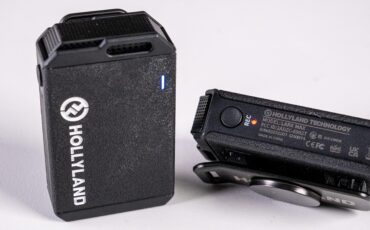Godox VIRSO and VIRSO S Wireless Audio Set Introduced – Sony Smart Hotshoe Connection
Godox joins the compact dual-mic fray with the new VIRSO set. At first glance, it looks fairly similar to other offerings such as the RODE Wireless Pro, DJI Mic, or Hollyland Lark, but it has some neat tricks up its sleeve, especially for Sony users concerning the VIRSO S version. We spoke about the new dual-mic with Wenxin Qiu from Godox at IBC 2023.
We’ll get to the spec list in a second, but first, let’s take a look at what is probably the most unique feature of the VIRSO S.
“S” stands for Sony
It just may be the first off-brand product that uses Sony’s proprietary smart hot shoe. The Sony version is a truly wireless solution, omitting the 3.5mm receiver-to-camera cable. The hot shoe connection enables three audio channels, so an additional mic has been added to the receiver, and now the camera operator can also join the conversation. It’s worth mentioning that the 3.5mm jack is still available on the VIRSO S, for the sake of versatility and the ability to work with either old models or other brands.

Long live the battery!
Compact devices naturally limit battery capacity, but Godox seems to achieve decent battery performance, according to the manufacturer’s claims. The transmitters will last for 13 hours while the receiver will outlive them by an additional 4 hours (17 total), so it will probably handle even the most demanding productions. There is also a charging case, which provides up to 40 hours. We’ll have to check those numbers in real life and your mileage may vary, especially when shooting in extreme weather conditions, etc.

Backup recording included
As with some recent wireless offerings, the Godox VIRSO enables internal recording at the transmitter level. “Transmitter level” means no wireless interference will jeopardize the source material, since it’s being recorded beforehand, providing us with much-needed peace of mind even as a single operator. Unlike some rivals, the Godox system does not rely upon internal memory but on the widely available Micro SD memory cards. This method is super simple and eliminates any concerns about available internal memory space. Just switch between cards and keep on rolling.
The system also provides an optional safety channel recording and according to Godox, an advanced noise-canceling feature.

Smooth operation – dial and click
The VIRSO system is fairly simple to operate. Most features and functions are selected, tuned, or changed with a single dial. Others, such as record start/stop, have a specific button with the traditional red dot and will perform an additional function with a long press.
Who is it for?
The Godox VIRSO system will probably find its place among independent filmmakers. Documentary filmmakers will find the impressive battery life and backup recording helpful, and so will content creators, small, or even medium production houses, local news producers, and commercial videographers.
Alternatives
The compact wireless market has gotten pretty crowded in recent years. Pioneered by RØDE, the Australian manufacturer still manages to offer some of the best alternatives around. The new RØDE Wireless PRO is pricier than the VIRSO but adds some fundamental improvements such as TimeCode generation, 32-bit internal recording, and more. The tried and true RØDE Wireless GO II is similar in price but lacks a pair of Lavalier mics and a charging case, and has a shorter battery life as well. The RØDE GO II offers better recording depth at 24 bits, as opposed to the 16-bit offered by the VIRSO system. DJI mic system will also record 24-bit and will do so at a slightly longer range but at the cost of a battery life of only 5 hours (transmitter). The Hollyland LARK MAX is similarly priced at $299 and offers 24-bit recording, a slightly longer range, and magnetic attachments, but falls short on transmitter battery life, and with no Lavaliers in the box.
All in all, it seems that the new Godox VIRSO is quite balanced, excelling with leading-class (claimed) battery life, and poses a unique smart attachment for Sony cameras, while falling short at internal recording capability.
Price and availability
The VIRSO kit sells for $249 and the VIRSO S will set you back an additional $50 ($299). The package includes two transmitters, one receiver, a charging case, two lav mics, two “dead cats” TRS-TRS and TRRS-TRS cables, and a lanyard.
Both sets along with other combinations (one transmitter set, a single transmitter, etc.) are currently available.
So what do you think about the Godox VIRSO/VIRSO S? Is it a mic you would be interested in, or do you have one of the other mics mentioned? Let us know in the comments below!


























